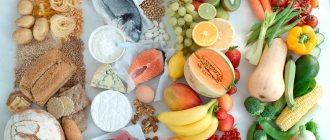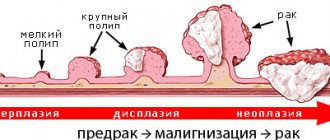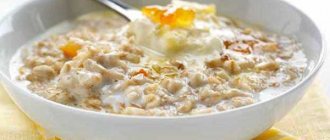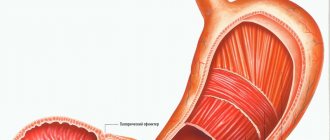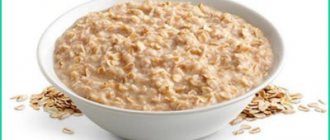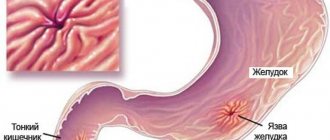Gastric ulcer is an extremely unpleasant disease that has become widespread in recent years. Almost half of the inhabitants of our planet suffer from gastritis, but not everyone develops it into an ulcer. Diet during exacerbation of a stomach ulcer is an important component that influences the dynamics of the disease. Therefore, this moment requires a special approach.
Basic nutrition rules
- The patient's food products must contain a sufficient amount of nutrients designed to cover a person's daily needs.
- Food products should not have an irritating effect on the mucous membrane of the digestive tract.
- The number of meals per day is multiple, the portions are small.
- You should not eat food that is too hot or too cold. Room temperature is quite acceptable.
- The food of a patient with an ulcer should not stimulate the production of hydrochloric acid in the stomach.
- You should not drink an excessive amount of water at a time; you need to drink the liquid little by little and often.
- Preference should be given to food in pureed form - puree, soufflé.
- There is a minimum amount of salt in products and ready-made dishes.
When prescribing a gentle diet, the intestines often suffer - constipation develops due to a lack of fiber in the diet. To avoid this, include more dishes with pectin in your diet. Food will be better evacuated through the digestive tract.
A doctor – gastroenterologist or nutritionist – should prescribe a menu for illness. The doctor will determine, based on the patient’s condition, what food is allowed at the current moment of illness, and what food will not harm the stomach.
Exacerbation of stomach ulcers, general idea
Due to disturbances in the secretory activity of the stomach, a disease called peptic ulcer may develop. It is characterized by the appearance of wounds of various sizes on the mucous membrane, the healing of which takes a long time.
According to many scientists, stomach ulcers are caused by the bacteria Helicobacter pylori, which are activated at a time when the human body is weakened.
Among the reasons contributing to the development of pathology are the following:
- Due to stressful conditions, experiences, and negative emotions, the production of gastric juice, which is based on aggressive hydrochloric acid, is activated. And it is capable of corroding the stomach walls if there is no food in it.
- Poor nutrition, consisting of irregular meals, snacking on low-quality products;
- Hereditary factor;
- Bad habits (smoking, alcohol abuse).
If you don’t stick to the diet, relying solely on the help of medications prescribed by the doctor, then you can’t hope for a favorable outcome of the disease. In moments of exacerbation, gentle nutrition will help the ulcer heal.
List of approved products
Based on the principles of proper nutrition described above, a list of products allowed for consumption in case of ulcerative lesions has been compiled. The list is extensive; any person will find a suitable set of food products, based on taste preferences, without causing harm to health. Let's look at what is allowed for stomach ulcers.
Milk and its derivatives
Patients suffering from ulcers should consume this product regularly. This fact confuses many people. In fact, the useful product neutralizes excess gastric secretions, preventing aggressive effects on the mucous membranes. In addition to its barrier function, milk is endowed with many beneficial qualities and contains a full range of nutrients.
Dairy
The consumption of dairy products in the acute period of a peptic ulcer should be treated with caution.
- For example, kefir is a product that has a laxative or strengthening effect. The impact of a dairy product depends on how it is stored at home.
- Patients who love sour cream have no reason to worry. The type of dairy product does not have to be excluded from the menu, but can be eaten exclusively as a seasoning for a salad or first course, not on its own.
- There is a common misconception that patients susceptible to ulcerative processes are contraindicated in consuming cottage cheese. The composition of cottage cheese contains a considerable amount of useful components that bring the product to the forefront in the series of products approved for consumption by patients with gastric or intestinal pathologies. It is recommended to take low-fat cottage cheese, preferably 5% fat.
- Yogurt is a useful food product for stomach ulcers. You should choose low-fat varieties without dyes or dried fruit additives. Whey is not recommended for consumption in the acute period.
Cheese
Mild and unsalted varieties of cheese are useful for peptic ulcers. Cheese is rich in a variety of proteins necessary for the construction of body tissues, indispensable during regeneration processes. In addition to proteins, cheese is rich in amino acids. The advantage of cheese is that the protein components of the product are already partially broken down during the enzymatic treatment that accompanies preparation, and the cheese is easily absorbed in the patient’s body.
Dairy products are healthy for ulcers, filled with minerals, vitamins and organic compounds that are beneficial to health.
Diet for ulcer remission
The diet should be lighter. The sick person does not need artificial vitamins, bed rest or a strict diet. The patient feels practically healthy and full of energy, so it is recommended to adhere to a proper balanced diet. From time to time, the diet needs to be supplemented with sedatives and antispasmodics.
Recommended foods:
- Bread – in addition to wheat, rye bread is allowed, but it should not be fresh. We recommend pies filled with meat, fish or cottage cheese, and dry biscuits;
- Milk and other dairy products. They should not be too sour, but yogurt or cheeses are quite acceptable, only low-fat;
- Vegetable and milk soups;
- Boiled or stewed vegetables;
- Sweets such as honey, marshmallows, jam and caramel. The rest of the food must be consistent with permitted and prohibited foods.
Vegetables
Vegetables and fruits are indicated in dietary nutrition and are full of biologically active valuable substances. An important component of plant foods is pectin. The main value is the high ability of the substance to envelop the walls of the stomach and intestines, preventing irritation of the epithelium and protecting it from aggressive influences. Pectin promotes good evacuation of dietary fiber through the intestinal lumen and serves to prevent the patient from constipation.
A valuable component is fiber, which ensures the excretion of food and movement through the intestines.
Cabbage
Vegetable juice has a beneficial effect on regeneration processes in the intestines and stomach. Thanks to the vitamins contained, ulcer healing occurs instantly. It is undesirable to consume cabbage raw or even boiled during an exacerbation of peptic ulcer disease. Boiled cauliflower is allowed to feed ulcers.
Potato
Boiled vegetables do not irritate the mucous membranes. Potatoes are part of any type of diet for peptic ulcers. Juice from raw potatoes deserves close attention: it reduces the increased acidity of gastric juice, eliminates vomiting, nausea, pain, heartburn in patients, and promotes the healing of ulcers.
Carrot
The orange root vegetable is useful to consume in any form; it contains a number of useful substances. Carrots are allowed for ulcers in boiled or stewed form. It is permissible to squeeze the juice, mix it with other juices, and drink it to heal the ulcer. You can add carrots to mashed potatoes in small quantities.
Celery
An approved product, used in any form for exacerbation of an ulcer. The squeezed healing juice is supposed to be drunk to speed up repair, you can cook soup or other dish. Celery juice has a pronounced anti-inflammatory and analgesic effect on the mucous membranes.
Pumpkin
The mentioned vegetable is distinguished by a minimal amount of coarse fiber in its composition, ensuring its suitability for nutrition even in the acute stage. Pumpkin is used to make puree, porridge with cereals and milk, soups and vegetable side dishes for meat. Exhibits a wound-healing and analgesic effect. During the remission stage, it is not prohibited to eat pumpkin seeds.
Greenery
Dill and parsley can be added in small quantities to the first or second courses, without overusing, so as not to provoke deterioration.
Vegetable oils are useful for restoring normal functioning of the digestive system. Olive oil for stomach ulcers has an enveloping, anti-inflammatory effect, contains a lot of vitamins and fatty acids, and promotes regeneration processes. Olive oil is used to season salads.
General principles of diet
Knowing and adhering to the general principles of the diet that is used for stomach ulcers, you will be able to create your own menu as correctly as possible and not aggravate the course of the disease.
Among them are:
- Balance. You cannot deprive the patient of the calorie content of his meals. The daily menu should be balanced, and the energy value should be no less than 3000 kcal.
- Fractionality. Breaks between meals should not be more than three hours.
- Minimum portion size. Ideally, each portion of food should fit into cupped hands.
- Prohibition on fried and golden-brown foods.
- Prohibition of very hot or very cold food. Dishes that have a temperature above or below 30 degrees inhibit the function of enzyme formation and slow down the process of restoration of the epithelial tissue of the stomach. This rule is especially relevant at the time of exacerbation of a stomach ulcer.
- Refusal of products that increase gas formation.
- Complete refusal or minimizing the amount of salt consumed.
- Increasing the volume of water to 2 liters, in the absence of thyroid diseases and pathologies of the urinary system.
- Avoid carbonated drinks and alcohol.
- Refusal of any foods that increase the production of gastric juice.
- Heat treatment of dishes is allowed: stewing, boiling, steaming, blanching.
- Priority is given to gentle food that does not irritate the stomach wall.
- The principle of sparing. Mechanical stomach sparing involves selecting certain foods to eat at one time. Chemical sparing consists of eliminating foods that irritate digestive secretions.
- The principle of zigzag nutrition. He assumes that for short periods of time the patient is allowed to eat foods from the prohibited list (within reason), and then he is returned to the diet menu. This principle is intended to serve as a kind of training for the gastrointestinal tract and is used only at the recovery stage.
- The principle of individuality. That is, when creating a menu, you cannot be guided by the same principles for everyone. Much depends on what stage the disease is at, where the ulcer is located, what the patient’s age is, what his body weight is, whether there are concomitant diseases, etc.
- Calculation of food digestion time. So 200 ml of water, tea or broth will stay in the stomach for an average of 1.5 hours. After three hours, meat, boiled vegetables, apples and bread will leave it. Fatty fish, fried meat, and legumes last the longest there – up to 5 hours.
As for the timing, the diet must be followed for at least one year after an attack of exacerbation of the disease. The main goal of dietary nutrition in this case is to accelerate the regeneration of the mucous membrane lining the stomach and normalize the digestion process.
Fruits
Fruits are discussed separately in the treatment of peptic ulcers. In the diet, preference is given to varieties of fruits and berries without hard skin that have a sweet taste. The harsh peel of the fruit is difficult to digest, irritating the mucous membrane. Fruits and berries can be consumed pureed, boiled, stewed or baked. It would be correct to prepare compote or jelly from them.
Fruits included in the list of suitable for use:
- bananas;
- strawberry;
- viburnum;
- currant;
- sea buckthorn;
- apples;
- pears.
It is recommended to prepare compotes and mousses from the berries, which will avoid loading the mucous membrane.
Meat and fish products
These dietary components may be consumed steamed. Meat is a valuable source of protein and fat. For a speedy recovery and dietary nutrition, beef or veal is most acceptable. These varieties are low in fat. Many patients prefer chicken meat due to its taste and low cost.
The degree of absorption of chicken meat is higher compared to beef. Nutria, rabbit meat, and turkey meat will be beneficial for the body. These types of meat products can be safely used for peptic ulcers.
When it comes to fish, the qualities of a river or sea product are very valuable. Biological substances included in the composition take part in regeneration processes. Fish and fish dishes are easily digestible, lighter than meat. A variety of dishes are prepared from fish.
Buckwheat soup with chicken broth can be eaten for lunch without risk to health.
Advice from a gastroenterologist
The very first thing the patient needs to do is to reevaluate his diet, because the presence of an ulcer already indicates that it is necessary to change eating habits. In fact, “rebuilding” your body on a dietary diet is not difficult. Within just a couple of weeks of the new diet, patients get used to it and begin to enjoy healthy food.
The main recommendations of experts will be:
- Reduce the harmful effects of hydrochloric acid. To do this, you need to stop drinking coffee, strong tea and carbonated drinks.
- Do not injure the mucous membrane of the organ. To do this, you should exclude rough foods with solid fiber from the menu.
- Don't eat "through force." It is also dangerous to eat during prolonged fasting, when a person does not control what exactly he eats.
Eggs
The most valuable part of the product is the yolk. It contains most of the components necessary for metabolism. For duodenal ulcers, eggs are boiled soft-boiled and eaten; this is the easiest form to digest. Eating raw eggs is fraught with infection and dangerous infectious diseases. Quail eggs have beneficial dietary properties.
Cereals are beneficial - buckwheat, rice, semolina, sago. They are boiled with milk and served as side dishes for vegetable or meat dishes. The cereal needs to be boiled well and ground. Porridges and soups are prepared from cereals in low-fat meat or vegetable broth.
Diet after ulcer surgery
To avoid any complications, you must adhere to an adjusted diet. Nutrition during this period is developed individually, since it is required to adhere to small portions of food consumed every couple of hours. In this case, all dishes should be at medium temperature to avoid sudden changes. The diet is based on several rules:
- chewing food thoroughly;
- drinking plenty of water, light teas and diluted juices are allowed;
- the correct diet should be followed until the body recovers completely;
- permitted vegetables should not contain vegetables and fruits containing large amounts of coarse fiber;
- a minimum amount of salt, low-fat yogurt without additives, zucchini, carrots, rice and semolina are the most optimal foods during the diet after surgery.
Such a diet should be balanced and contain all useful elements. The food is steamed or simply boiled. On the first day after surgery, the patient must be on a starvation diet, then he switches to a gentle diet. For the first couple of months, it is advisable to eat pureed food, and then switch to normal food. It is usually observed for about a year after surgery.
Beverages
Patients are interested in what tea they can drink for ulcers.
Green tea is useful for ulcers. The drink is rich in antioxidants, helps heal ulcers and relieve inflammation. Don't drink it too strong or hot.
Patients often ask the question which juices will not harm stomach ulcers. Vegetable juices that are allowed for illness include cabbage, potato, carrot, beet or celery juice. To improve taste, dilute with apple drink. Fruit juices for ulcers can only be drunk from ripe and sweet fruits. Juices that are too sweet are diluted with boiled water.
Chicory has a positive therapeutic effect for duodenal ulcers. A drink from the root of the plant replaces coffee in taste without causing side effects. Kombucha is a healing drink.
Symptoms and manifestations of ulcers
The following are common symptoms and signs of stomach ulcers:
- Nausea and vomiting (with exacerbation of the disease, vomiting may be mixed with blood).
- Severe heartburn and burning sensation in the chest.
- Unpleasant belching.
- Weight loss.
- Constipation.
- Loss of appetite.
- Quick satiation with food.
- Pain in the stomach area. Moreover, pain often occurs between meals and is quickly suppressed after eating warm food.
Important! Not everyone knows that sometimes an ulcer can proceed for a long time without any obvious signs at all. This is the so-called latent form of the disease, which does not make it any less dangerous.
If such symptoms occur within a few days, then you should immediately consult a doctor who will conduct a diagnosis and make an accurate diagnosis.
Prohibited foods
It is worth considering in detail what you should not eat if you have a stomach ulcer. Below is a list of prohibited products.
Vegetables
- The diet of an ulcer should not include raw vegetables with coarse fiber, which irritate the mucous membrane mechanically and chemically. During the acute period, do not eat tomatoes, garlic, turnips, onions, raw cabbage, or vinaigrette.
- Grapes are contraindicated for duodenal ulcers; they have a high content of sugar and active acids. It is not recommended to drink grape juice during an exacerbation of an ulcer. In the acute period, pomegranate is excluded, the fruit is sour, which will negatively affect the condition of the mucous membrane. During the remission stage, it is permissible to drink diluted pomegranate juice to restore hemoglobin. Cranberries are harmful for stomach ulcers, just like lemon.
- Fatty, heavy dishes such as dumplings, shish kebab, fried pork and lamb cutlets are strictly contraindicated for stomach ulcers; liver and lard are prohibited.
- Nuts and seeds have a mechanically irritating effect on the stomach wall and are strictly contraindicated for intestinal and stomach ulcers. Walnuts are strictly not recommended.
- Mushrooms are extremely difficult on the stomach and are not recommended for consumption even in remission.
- Spicy seasonings - garlic, ginger, pepper - are strictly contraindicated. Herbs are full of irritating properties and stimulate gastric juice. Tomato and nut sauce are contraindicated.
- In the acute period of an ulcer, you should not try dried fruits. Dried apricots or prunes are harmful and injure weakened mucous membranes. But during the period of remission, prunes with honey prevent constipation and restore body tone.
- If you have a stomach disease, avoid fatty foods, sausages, liver, caviar, and lard. Butter can be used in small doses to season soups or porridge.
Lard, salted fish, and sausage are not recommended even during remission. Lard is a difficult product for the stomach. Patients are wondering whether jellied meat is allowed for peptic ulcers. During an exacerbation, the dish is contraindicated.
As the patient recovers health, the diet gradually expands, but returning to a nutritious diet is acceptable after a year from the start of recovery.
Nutrition for a bleeding ulcer
During bleeding, you should follow a special diet. At first, you should adhere to parenteral nutrition, that is, the introduction of all nutrients through intravenous infusion. All nutrition during this period should not go through the gastrointestinal tract. When doctors stop it, the patient is allowed to consume about 200 ml of cold food in liquid form.
Kissel, cream, milk are the most optimal, then add raw eggs and sour cream. Slimy soups and table No1A are also added to the diet. With a bleeding ulcer, cases of anemia are common, so the diet should contain a maximum of protein and a minimum of fat. Liver and yeast are popular. After a couple of months, vegetables and fruits are added.

